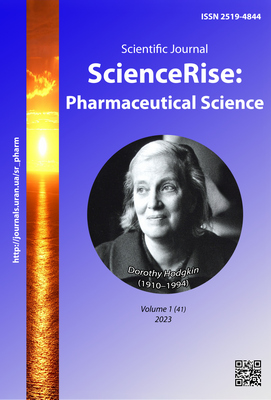Technology of obtaining and chemical profiles of dry extracts from leaves of prospective species of the hawthorn genus
DOI:
https://doi.org/10.15587/2519-4852.2023.274772Keywords:
hawthorn, leaves, dry extracts, chemical profile, technology, flavonoids, hydroxycinnamic acids, amino acidsAbstract
The aim of the work was to develop a technology for obtaining dry extracts from leaves of non-pharmacopoeia species of hawthorn and establishing their chemical profiles.
Materials and methods. Leaves of Crataegus mollis Sarg., Crataegus submollis Sarg. and Crataegus arnoldiana Sarg., used to obtain the dry extracts, were harvested in the Botanical Garden of the National University named after M. N. Karazina in August 2021. To determine the chemical profiles of the obtained dry extracts, the spectrophotometric method and the high-performance liquid chromatography (HPLC) method were used.
Results. A technological scheme for obtaining dry extracts of hawthorn leaves has been developed. The content of flavonoids and hydroxycinnamic acids in dry extracts of the leaves of C. mollis Sarg., C. submollis Sarg. and C. arnoldiana Sarg. was determined. The content of free amino acids in extracts ranges from 0.70 % to 0.99 %. The content of flavonoids ranged from 7.25 %±0.04 to 8.43 %±0.01, of hydroxycinnamic acids - from 2.35 %±0.02 to 2.85 %±0.03. Rutin, kaempferol-3-O-glycoside, epicatechin and chlorogenic acid were identified in all extracts by the HPLC method. In dry leaf extracts of C. arnoldiana Sarg. and C. mollis identified p-coumaric acid; C. arnoldiana Sarg. – quercetin; C. arnoldiana Sarg. and C. submollis Sarg. – ferulic acid; C. submollis Sarg. and C. mollis Sarg. – quercetin-3-O-rhamnoside.
Conclusions. Dry leaf extracts of C. mollis Sarg., C. submollis Sarg. and C. arnoldiana Sarg. were obtained. For the first time, the content of flavonoids and hydroxycinnamic acids in the extracts was determined by HPLC. It was established that the chemical profile of the obtained extracts is formed by rutin, chlorogenic acid and kaempferol-3-O-glycoside, which can be used in further standardization of these substances. In addition, a comparative study of the amino acid composition of the obtained extracts was carried out for the first time
References
- Kumar, D., Arya, V., Bhat, Z. A., Khan, N. A., Prasad, D. N. (2012). The genus Crataegus: chemical and pharmacological perspectives. Revista Brasileira de Farmacognosia, 22 (5), 1187–1200. doi: https://doi.org/10.1590/s0102-695x2012005000094
- Georg Belz, G., Loew, D. (2003). Dose-response related efficacy in orthostatic hypotension of a fixed combination of D-camphor and an extract from fresh Crataegus Berries and the contribution of the single components. Phytomedicine, 10, 61–67. doi: https://doi.org/10.1078/1433-187x-00303
- Furey, A., Tassell, M., Kingston, R., Gilroy, D., Lehane, M. (2010). Hawthorn (Crataegus spp.) in the treatment of cardiovascular disease. Pharmacognosy Reviews, 4 (7), 32–41. doi: https://doi.org/10.4103/0973-7847.65324
- Furey, A., Tassell, M. (2008). Towards a systematic scientific approach in the assessment of efficacy of an herbal preparation: Hawthorn (Crataegusspp.). European Journal of Heart Failure, 10 (12), 1153–1157. doi: https://doi.org/10.1016/j.ejheart.2008.10.003
- Bahri-Sahl, R., Ammar, S., Fredj, R. B., Saguem, S., Grec, S., Trotin, F., Skhiri, F. H. (2009). Polyphenol Contents and Antioxidant Activities of Extracts from Flowers of Two Crataegus azarolus L. Varieties. Pakistan Journal of Biological Sciences, 12 (9), 660–668. doi: https://doi.org/10.3923/pjbs.2009.660.668
- Hwang, H. S., Boluyt, M. O., Converso, K., Russell, M. W., Bleske, B. E. (2009). Effects of Hawthorn on the Progression of Heart Failure in a Rat Model of Aortic Constriction. Pharmacotherapy, 29 (6), 639–648. doi: https://doi.org/10.1592/phco.29.6.639
- Derzhavna Farmakopeia Ukrainy. Vol. 1. Kharkiv: RIREH, DP «Ukrainskyi naukovyi farmakopeinyi tsentr yakosti likarskykh zasobiv», 1128.
- European Pharmacopoeia (2010). Strasbourg: Counsil of Europe, 1, 1147–1148.
- Sydora, N., Kovaleva, A., Goncharov, A. (2018). Search of the promising species of subfamily Amygdaloideae and Pyroideae using the chemotaxonomy. ScienceRise: Pharmaceutical Science, 6 (16), 21–25. doi: https://doi.org/10.15587/2519-4852.2018.153199
- Khokhlova, K. O., Zdoryk, O. A., Sydora, N. V., Shatrovska, V. I. (2019). Chromatographic Profiles Analysis of Fruits of Crataegus L. Genus by High-Performance Thin-Layer Chromatography. European Pharmaceutical Journal, 66 (2), 45–51. doi: https://doi.org/10.2478/afpuc-2019-0020
- Derzhavna Farmakopeia Ukrainy (2009). Kharkiv: RIREH, DP «Ukrainskyi naukovyi farmakopeinyi tsentr yakosti likarskykh zasobiv», 280.
- Sydora, N., Zuikina, S., Kovaleva, A., Vyshnevska, L. (2018). Technology of obtaining and investigation of chemical composition of dense extract of hawthorn fruits. ScienceRise: Pharmaceutical Science, 5 (15), 31–39. doi: https://doi.org/10.15587/2519-4852.2018.146473
- Lenchyk, L. (2016). Determination of phenolic compounds in prunus domestica leaves extract. Scripta Scientifica Pharmaceutica, 2 (2), 31–35. doi: https://doi.org/10.14748/ssp.v2i2.1302
- Long, S. R., Carey, R. A., Crofoot, K. M., Proteau, P. J., Filtz, T. M. (2006). Effect of hawthorn (Crataegus oxycantha) crude extract and chromatographic fractions on multiple activities in a cultured cardiomyocyte assay. Phytomedicine, 13 (9-10), 643–650. doi: https://doi.org/10.1016/j.phymed.2006.01.005
- Mraihi, F., Fadhill, H., Trabelsi-Ayadi, M. (2015). Chemical characterization by HPLC-DAD-ESI/MS of flavonoids from hawthorn fruits and their inhibition of homan tumor growth. Journal Of New Sciences, 3, 840–846.
- Chen, J., Song, S., He, J., Xu, S. (2008). A study of the chemical constituents of the leaves of Crataegus pinnatifida. Asian Journal of Traditional Medicines, 3, 80–83.
- Liu, P., Kallio, H., Lü, D., Zhou, C., Yang, B. (2011). Quantitative analysis of phenolic compounds in Chinese hawthorn (Crataegus spp.) fruits by high performance liquid chromatography–electrospray ionisation mass spectrometry. Food Chemistry, 127 (3), 1370–1377. doi: https://doi.org/10.1016/j.foodchem.2011.01.103
- Hamahameen, B. A., Jamal, B. (2013). Determination of Flavonoids in the Leaves of Hawthorn (Crataegus Azarolus ) of Iraqi Kurdistan Region by HPLCAnalysis. International Journal of Bioscience, Biochemistry and Bioinformatics, 3 (1), 67–70. doi: https://doi.org/10.7763/ijbbb.2013.v3.166
- Jámbor, A., Molnár-Perl, I. (2009). Amino acid analysis by high-performance liquid chromatography after derivatization with 9-fluorenylmethyloxycarbonyl chloride. Journal of Chromatography A, 1216 (15), 3064–3077. doi: https://doi.org/10.1016/j.chroma.2009.01.068
- Mraihi, F., Hidalgo, M., de Pascual-Teresa, S., Trabelsi-Ayadi, M., Chérif, J.-K. (2015). Wild grown red and yellow hawthorn fruits from Tunisia as source of antioxidants. Arabian Journal of Chemistry, 8 (4), 570–578. doi: https://doi.org/10.1016/j.arabjc.2014.11.045
- Vyshnevska, L., Severina, H. I., Prokopenko, Y., Shmalko, A. (2022). Molecular docking investigation of anti-inflammatory herbal compounds as potential LOX-5 and COX-2 inhibitors. Pharmacia, 69 (3), 733–744. doi: https://doi.org/10.3897/pharmacia.69.e89400
- Lenchyk, L., Shapoval, O., Kyslychenko, V. (2016). Phytochemical study and determination of pharmacological activities of cherry shoots dry extract. ScienceRise: Pharmaceutical Science, 1 (1), 40–45. doi: https://doi.org/10.15587/2519-4852.2016.72746
Downloads
Published
How to Cite
Issue
Section
License
Copyright (c) 2023 Natalia Sydora, Volodymyr Yakovenko, Oleksandr Ochkur, Anna Rudnyk, Oleksandr Honcharov, Svetlana Zuikina, Kateryna Romas, Mykhailo Marchenko

This work is licensed under a Creative Commons Attribution 4.0 International License.
Our journal abides by the Creative Commons CC BY copyright rights and permissions for open access journals.








